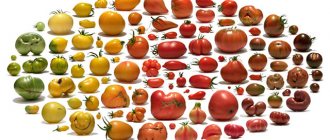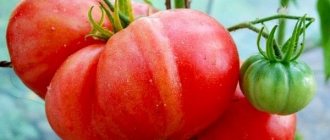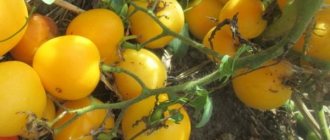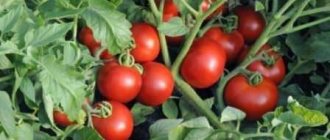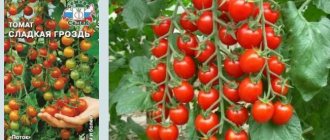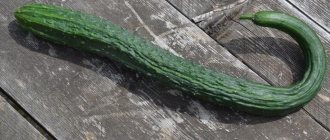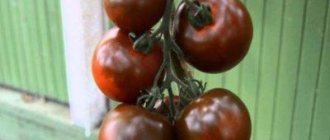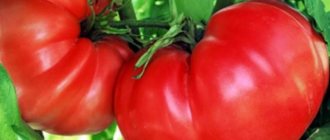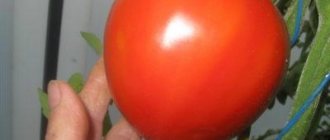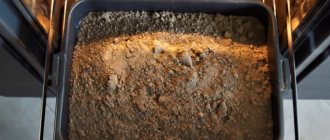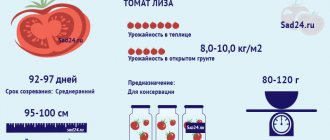Tomato Red Franchi pears are an interesting find for gardeners. Franchi's selection is located in Italy and is famous all over the world for its productive varieties.
| Height | Landing location | Ripening time | Fruit color | Fruit size | Origin | Fruit shape |
| Tall | Greenhouse, Open ground | Mid-season | Reds | Large | Variety | Pear-shaped |
Description of the tomato variety Red Pear with photo
The variety is classified as indeterminate (not limited in growth). The plant has medium foliage, usually forms one or two stems, and is very compact.
The leaves are medium-sized, bright green, dissected into lobes. The inflorescences are simple, collected in racemes, appearing every three leaves. The roots are powerful, widely distributed in the upper layers of the soil, and the main tap root goes at least 0.5 m deep (depending on the looseness of the soil). The Red Pear tomato, like other varieties, is capable of forming additional roots when the main stem is hilled high. The variety is classified as mid-season. The time from the appearance of the first shoots to the ripening of the fruit depends on the growing region and the place where the vegetable crop is planted and averages one hundred days.
Red Pear tomato seeds can be harvested independently from fully ripened fruits
Description of fruits
The fruits are unusually pear-shaped, their skin is dense, smooth, and ribbing is visible on some specimens. At the stage of full ripeness they acquire a bright scarlet color. Up to ten fruits ripen in each cluster. The tomatoes are small in size, fleshy, weighing 80-100 g each. The fruits have two chambers, and there are very few seeds in them. The dry matter content is high. The taste is pleasant, sweetish, with a slight note of sourness.
Brief description of tomato
The Red Pear tomato is a mid-season variety that begins to bear fruit 115 days after planting. The ripening period of the fetus takes up to 5 weeks. This is also an indeterminate, that is, tall-growing type of tomato. As a rule, the standard height of a bush ranges from 140 to 150 cm.
These tomatoes have good yields. For example, up to 2.5 kg of fruit can be collected from one bush. They have a small but characteristic pear-shaped shape (hence the name of the variety). The average weight of one tomato is 80 g. The fruits also attract attention with their beautiful rich red color.
Characteristics of the red pear tomato
The variety has a medium ripening period and produces stable annual yields; it takes about 3.5 months to reach fruit maturity. Plants are drought-resistant, can tolerate short-term lack of watering, and do not tolerate drafts and northern winds. Transportability is high; you can safely transport it over long distances without losing its presentation. Tomatoes are distinguished by their shelf life; at a temperature of +3 ⁰С they retain their appearance, taste and shape for 1.5 months. Plants need constant pinching, the formation of one or two stems. As soon as it reaches a height of 50 cm, it is tied to a support or trellis and then this is done regularly.
It is recommended to grow the variety in all regions of the Russian Federation, except the northern ones. Tomatoes are planted both indoors and outdoors.
The Red Siberian Pear tomato was created especially for harsh weather conditions, the description and characteristics of which indicate earlier ripening periods, the possibility of long-term storage, resistance to low temperatures and late blight.
Tomato yield Red pear and fruiting
Subject to all the rules of agricultural technology, the ripening of Red Pear tomato fruits occurs from mid-July until autumn frosts. The guaranteed yield is at least 3-4 kg per bush. Up to 15 kg of fruits are harvested from a square meter when four plants are placed on it. Productivity largely depends on the timing of sowing seedlings, light, humidity, temperature, soil fertility and quality of care.
Tomatoes can be removed from the branches at the browning stage and ripened by placing them in boxes and placing them in a warm place (+23 ⁰C). At the same time, their quality remains high.
In the southern regions, the Red Pear tomato can be grown without seedlings
Area of application of fruits
Tomato Red Pear for universal use. Beautiful, small-sized, unusually shaped tomatoes are used for whole-fruit canning. The peel does not burst during heat treatment, maintaining its appearance and integrity. The preparations are not only tasty, but also beautiful.
From the Red Pear tomato variety you can prepare snacks, salads, pasta, lecho and ketchups. The juice is very thick due to the high dry matter content. It is possible to freeze fresh fruits for further use in cooking.
Resistance to diseases and pests
Thanks to its strong immunity, the Red Pear tomato is resistant to late blight and gray rot. If growing conditions are observed, temperature and humidity are controlled, the plant is not susceptible to disease. If cold weather and prolonged rainy weather occur, the resistance of tomatoes decreases and the risk of contracting fungal and viral infections increases. In greenhouse conditions, with a long absence of watering, the development of blossom end rot and attack by insect pests is possible.
Planting seedlings in the ground
When planting tomatoes in the Red Pear garden, keep in mind that the best time for these purposes is the beginning of June, but only after the frosts have ended and summer weather has set in. Before you begin this procedure, prepare the planting site - dig holes and fill them thoroughly with water. The optimal distance for placing bushes is 30-40 cm.
READ MORE: Basil (photo) - planting and care, varieties and types
Tomatoes belonging to the Red Pear variety should not be planted in the same place in the garden for more than 3 years in a row. It is best to place the beds in areas where cucumbers, zucchini or cabbage used to grow.
Sowing seeds is done in two ways: in seedling boxes and directly into the ground. The first method is used in the northern regions and areas of the middle zone. The second method is practiced in the south of the country.
Sowing work is planned approximately 2 months before transferring the seedlings to a permanent place. The optimal period is the last ten days of February or the first ten days of March. Seeds collected by hand from previously grown tomatoes are processed. They are soaked in a slightly pink solution of potassium permanganate for 2 hours, then washed with clean water.
Seeds in packaging are processed in production.
Soaking in germination stimulants: “Epin”, “Zircon”, “Immunocytophyte” will not hurt. Folk remedies are also popular:
- Aloe juice is diluted with water in a 1:1 ratio and the seeds are immersed in the solution for 4-6 hours.
- A teaspoon of bee honey is dissolved in 200 ml of warm water and the grains are soaked for 5-6 hours.
The soil for growing seedlings is prepared from equal parts of turf, peat and river sand, or a ready-made substrate is used in bags marked “universal”. The soil, prepared independently, is fertilized with organomineral compositions “Ogorodnik” and “Universal”. They contain substances necessary for rapid growth and nutrition of plants: potassium, magnesium, phosphorus, sodium, sulfur, iron, zinc.
The seedling boxes are filled with moist soil and the seeds are placed in furrows 2 cm deep at a distance of 2-3 cm. Sprinkle the top with a 1 cm layer of soil and cover with glass or cling film. The boxes are taken to a dark place. The seeds hatch after 4-5 days at a room temperature of 25 °C.
The cover is removed daily to ventilate the soil and prevent mold.
Seedling care
After the sprouts appear, the boxes are placed in a sunny place. They try to maintain the air temperature within 22 °C. If there is a lack of sunlight, phytolamps are installed above the seedlings at a height of 60-70 cm.
Seedlings are transplanted into individual pots after the first true leaf appears. Plastic containers or peat glasses are suitable for this purpose.
Seedlings are provided with moderate watering 1-2 times a week. Fertilizers “Agricola” and “Effekton” are used for feeding once every 14 days.
The agricultural technology of tomatoes in protected and unprotected soil is not fundamentally different.
The period for transferring tomatoes into open and closed ground varies depending on the region of growth. In the northern regions and regions of the middle zone, planting is carried out in early May in greenhouses. In the southern regions, seedlings are planted in open ground in early June. For planting, choose a sunny area without drafts.
The greenhouses are kept open during the day and closed at night.
After the fruits appear, the frequency of watering is reduced to once a week. In dry weather, plants are watered more often.
Advantages and disadvantages
The unusual shape and bright color of the fruit are an undoubted advantage of the tomato. But it is not the only reason why amateur gardeners and farmers choose the Red Pear variety for growing on their plots and in greenhouses.
The best predecessors for red pear tomato are cabbage, pumpkin, legumes
pros
- the possibility of collecting seeds from the obtained fruits;
- their high germination rate;
- excellent immunity;
- versatility of use;
- good taste of tomatoes;
- duration of the fruiting period;
- increased transportability;
- significant shelf life;
- no cracking during heat treatment;
- annual high yield.
Minuses
- the need for pinching and tying up bushes;
- painful reaction to the presence of drafts.
Characteristics and description of the tomato variety
The variety was bred through high-quality selection of Pink Giant tomato seeds. In regions with cool climates, pears are grown in greenhouse conditions . In the southern regions of the country, tomato is cultivated in open ground.
The bush reaches a height of 1.3 m, but in greenhouse conditions the crop grows up to 1.7 m . From the moment of planting to the harvest of the first harvest, 105-115 days pass. The variety shows good yield if the pear is formed into one stem. The plant needs pinching and tying the bush to a support.
Distinctive characteristics of the fruit
Dense, fleshy tomatoes have a smooth shell . The shape of the fruit resembles a pear. The color of the vegetables is deep pink. When growing the variety in open ground, the weight of one tomato reaches 50 g, in greenhouse conditions - up to 75 g. Up to 11 kg of crop is harvested from one square meter if there are no more than 4 bushes on it.
The variety is universal in use . Tomatoes are used to make juice, sauce, and adjika. Tomatoes are also great for winter preparations.
On a note. Due to their excellent taste and good presentation, tomatoes are successfully sold in markets and grocery stores.
Features of cultivation
To get a good harvest you need strong and healthy seedlings. They act according to the algorithm:
- The box and the prepared soil mixture are disinfected.
- The seeds are sorted and soaked in a solution of potassium permanganate.
- They are treated with a growth stimulator.
- Lay out on the surface of the soil, embed to a depth of 1 cm.
- Cover with glass or film and place in a warm place (+25 ⁰C).
- After the emergence of seedlings, the shelter is removed and the box is transferred to a cool place (+18 ⁰C).
- Organize additional lighting for seedlings.
- Seedlings dive into separate containers after the appearance of two true leaves.
Seedlings may die if planted in soil whose temperature is below +10 ⁰С
At two months of age, the plants are transplanted into a greenhouse or ridge, installing a temporary shelter. The soil should be warm, loose, and moderately moist. Humus and ash are added to it in advance. For each tomato, prepare holes, placing them at a distance of 60 cm from each other (four per 1 square meter). Planted on a cloudy, rainy day. To do this, the seedlings are first watered, then carefully removed from the containers and the root system is placed in the hole. Cover with soil, tamp down a little, water and mulch. Later, each plant is given a reliable support for tying.
Subsequent care for the Red Pear tomato consists of watering, fertilizing, loosening, weeding and pinching.
Watering and fertilizing
Watering is carried out at least twice a week, using 2 liters of water for a young plant, and up to 5 liters for an adult plant. The best time for the procedure is early morning or late evening. Red Pear tomatoes should be watered with warm, settled water strictly at the root, avoiding dripping on the foliage. After each moistening, the soil is loosened, removing weeds and mulching the surface.
Fertilizing is carried out three times per season - at the beginning of the growing season - with nitrogen fertilizers, during the flowering period - with phosphorus-potassium fertilizers, at the stage of fruit formation - with complex mineral fertilizers.
Important! It is necessary to periodically ventilate the greenhouse to remove condensation and reduce humidity.
Stepchildren are removed when they reach a length of 8-10 cm
Stepsonning and formation
To properly form a bush, it is necessary to regularly remove the stepsons, preventing them from growing and thickening the tomato. For an indeterminate variety, it is enough to leave one or two main stems, and after they reach a height of 2 m, pinch off the tops to stop growth and stimulate the formation of ovaries.
Important! As the fruits form, it is recommended to gradually remove the lower leaves for ventilation and free access of air to all parts of the plant.
Seedlings should be planted in open ground at the end of May.
Tomato Pear red. Let's sum it up
This summer I participated in testing Agro seeds for the first time.
This determinate tomato variety attracted the attention of the market with its high yield, early ripeness, suitability for canning, and expected excellent taste. Tomato Pear red
The main stages of development of the red Grushka tomato from seed to harvest are described in detail in the reports: To stage I: Red Grushka tomato. If you hurry, you will make people laugh. To stage II: Tomato, red pear. One step closer to the harvest By stage III: Tomato Red pear. Waiting for the harvest Growing region : Volkhov district of the Leningrad region. Soil : heavy loam with the addition of compost . Place : sunny, arc greenhouse, oriented from west to east, with covering material Spunbond 42 g/m². Greenhouse dimensions: 4 x 1 m, height 1 m, i.e. bed area 4 m². 16 cucumber and tomato plants were planted in the greenhouse (each plant accounts for 0.25 m² of area).
Ads by
Test progress
2 plants were tested.
The seed soaking date is March 23rd. The appearance of seedlings is March 23-27. Intermediate germination - 100%. On the day of germination, the sprouted seeds were planted in Terra Vita universal soil. Shoots - March 27-April 2. Germination rate - 100%. 04/02/19. Tomato sprouts Red Pear - 3rd row from the bottom 04/14/19. Tomato seedlings Grushka red (1 row from the bottom) before picking. Tomato seedlings Grushka red were grown without stimulation, fertilizing and additional lighting. Picking tomato seedlings Red Pear - April 16.
04/24/19. Tomato seedlings Grushka red
Caring for seedlings consisted of watering as needed, shading in sunny weather and periodically turning the plants when tilted towards the light.
Planting seedlings in a greenhouse - June 8.
06/08/19. Red pear tomato seedlings before planting in the ground. For planting, I made a shaft of grass and lupins (it turned out very picturesque). I made a hole in the grass bank and filled it with fertile soil. I decided to plant the seedlings lying down, deepening the trunk up to the cotyledon leaves.
06/09/19. Tomato seedlings Grushka red after planting in a greenhouse
Mass flowering - July 14. The first ovaries are on July 21.
07/14/19. The red pear blossomed
07/21/19. Red pear - the first ovaries appeared
08/10/19. New tomato fruits set. Red pear
The plants were mulched with fresh grass and watered with herbal infusion based on the drug “Shine 3.”08/18/19. Formation of plants into 1 stem, one - into 2 stems. The height of the plants is about 1 m, corresponding to the height of the greenhouse. Plants have 3-4 flower clusters. I regularly remove the emerging shoots and lower leaves. 08/18/19. On another tomato plant, Pear red bears fruit with a large forked raceme.
08/27/19. The first blight spots appeared on some leaves. I removed the lower and diseased leaves and stepchildren.
09/07/19. Despite spraying with Biospectr, late blight could not be avoided. The disease spread from the leaves to the fruits, so we had to urgently harvest the crop and uproot the diseased plants. If not for the disease, the harvest would have been significantly larger, since there are many small fruits.
Emergency harvesting in a state of technical ripeness - September 7. I chose 2 plants for testing. Plant height - 1 m.
On the first plant, formed into 2 trunks, 3 fruit clusters were formed. Harvest from the first plant - 169 g.
The second plant, formed into 1 trunk, has 4 brushes. The harvest from the second plant is 153 g. The weight of the largest tomatoes is 34-35 g.
A third of the crop was affected by late blight. I removed the diseased plants from the greenhouse and mulched them with grass for berry bushes. I placed healthy fruits in sphagnum moss for ripening. Healthy fruits were placed in sphagnum moss for ripening
Testing of the Grushka red tomato is almost finished. It remains to wait for the fruits to ripen to evaluate the taste. 09.25.19. The ripening of the red pear tomato in moss went without any losses.
09.25.19. The largest fruits of the tomato red pear are ripe
table of correspondence
| Options | Stated | Actually | Note |
| Planting time, germination time | 01.03-15.03 | 23.03 27.03-02.04 | Does not match |
| Transplantation to a permanent place | 25.05-10.06 | 08.06 | Compliant |
| Planting scheme | 50*35=0.17 m² | 0.25 m² | More comfortable landing conditions |
| From full shoots | 100-110 days | more than 150 days before technical ripeness | Does not correspond (it was a very cold summer) |
| Harvesting | July-September | September | Compliant |
| Plant height, cm | 90-100 | 100 | Compliant |
| Weight of 1 fruit, g | 60-70 | 34-35 | Does not match |
| At technical ripeness, the largest fruit is 35 g. | |||
| Yield (kg/m²) | 12-13 | 0,644 | Does not match |
Conclusions and impressions
Most of the parameters of the Grushka red tomato correspond to the varietal characteristics declared by the manufacturer.
Significant differences in fruit weight, yield and growing season may have been caused by very cold weather during this period, which did not allow the plant to show its full potential (the harvest could have been larger and earlier). The plant is 100 cm high, as stated by the manufacturer. I liked the variety. It’s a pity that the vagaries of the weather and late blight did not allow us to get a full harvest. I liked the taste of the fruit. The variety will be good for canning. Next season the experience should be repeated, hopefully in more comfortable conditions. Thanks to Agro for the opportunity to get acquainted with this variety.
Pest and disease control
The Red Pear tomato is resistant to late blight, but in unfavorable weather conditions infection is possible. In this case, treatment with copper sulfate and drugs that strengthen the immune system is necessary. Sick plants planted next to tomatoes can cause them to become infected with white rot. At the first manifestations of pathology, parts of the tomato or the entire bush are removed and disposed of. For preventive purposes, the foliage is sprayed with a weak solution of potassium permanganate.
To combat whiteflies, mole crickets, and Colorado potato beetles, insecticides “Grom,” “Karate,” and “Killer” are used.
Growing tomatoes
How to prepare seeds?
Before planting, it is recommended to prepare the seeds:
- Separate unusable material from suitable material. To do this, place the seeds in a solution of salt water. Spoiled and empty seeds will float.
- Disinfect. Manganese solution or other disinfectant solutions can kill microorganisms in the seeds if they are placed in the solutions for at least 20 minutes.
- Treat with bioactive substances. Aloe juice will help increase the immunity and productivity of plants if you keep the seeds in it for 12 hours.
Tomato pink pear description
The pink pear variety was bred on the basis of the pink giant variety. In warm regions it is grown in garden plots, and in regions with cold conditions - in greenhouses. The tomato bush reaches a height of about half a meter; when grown in greenhouses, the height is slightly higher. The bush must be tied to a support and be sure to have a stepson.
The fruits of this variety have smooth skin and are shaped like a pear. Hence the name of the variety. If you grow these tomatoes in a summer cottage, their weight will be about 50 grams, and when grown in a greenhouse, their weight will be more than 70 grams. The pink pear variety can be used for making juice, adjika, as well as for any preparations for the winter. Such tomatoes are sold with great success in stores.
The main advantages of this variety include:
- Good taste;
- Wide range of applications;
- Beautiful appearance;
- High yield;
- Long-term storage;
- Resistance to various diseases.
The main disadvantages of the variety:
- The bush needs tying up;
- It is necessary to constantly remove stepsons from the bush;
- If there is not enough moisture, the roots begin to deteriorate.
How to properly grow pink pear seedlings
Material for planting is taken only from large and ripe tomatoes. The seeds are separated from the tomato, washed and dried on paper. Before sowing dried seeds, they are soaked in a weak solution of potassium permanganate. To ensure that future seedlings are resistant to changing weather conditions, the seeds are placed in the refrigerator for a day.
